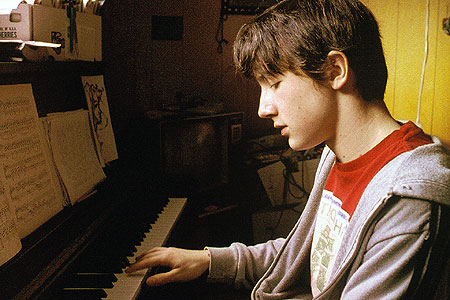I think the scene that most stroke me because of his power was the scene when Eric finds Mr. Luce the high school director in the corridor. Mr. Luce begs for his life and Eric decided (at first appearance) to let him alive and as a condition, to help and support people that suffer bullying from the others and not let them being bullied (like he did with Alex and Eric). This is the first and last sign of humanity from the killers of the whole movie.
2) What also impressed you?
 The fact that the two boys found and bought guns so easily in the web and even more the fact that in less than one day, they had the guns at home, without even requiring an identification, impressed me a lot.
The fact that the two boys found and bought guns so easily in the web and even more the fact that in less than one day, they had the guns at home, without even requiring an identification, impressed me a lot.
Without the shadow of a doubt even if the scenes showing the finding and purchase of the weapons were very short, the director was very accurate and wanted to show with these precise few short scenes the fact that in the USA you can get a gun in a very limited time. It was like a visual metaphor to show the easiness with which you can be armed.
3) Did you find anything more particularly upsetting?
3) Did you find anything more particularly upsetting?
I found particularly upsetting the character of Eric (except in a few moments). I think he is a cliché character, he plays violent videogames, he watches videos of the nazis,etc. He is a brainwashed guy, feeling no culpability because of his murders. He tries to be funny when it's not the moment (in the cafeteria). He is not the contrary of Alex but Gus Van Sant used other techniques to represent him. The viewer tries to understand Alex whereas with Eric the viewer just see him as a bad and "silly" boy. Another interesting and upset thing is that he is a coward, he is not able to kill looking to the face of his victims (even when he plays videogames).
4) What did you find very disturbing?
What stroke me most in the film was the fact that obviously the viewer tries more to emotionally understand Alex, the first killer, first of all because he is the one who shows a more sensitive side (we see him being bullied, we see him playing a Beethoven's sonata,etc.) however, the viewer is always trying to see a sigh of humanity, of goodness, but s/he never finds it. He seems to be sensitive when he actually is a remorseless person.
The most shocking was the scene in the shower with Alex and Eric. Is the first and last time the viewer sees emotions in this two boys. The scene is shoking because they'd just watched a Hitler's documentary and they'd just unbox the guns. This scene also shocks regarding to the rest of the film because they are going to murder a lot of people in cold blood.
6) What does the film suggest about the two school shooters?
6) What does the film suggest about the two school shooters?
 I think the film suggest and present them as an example of barbarism. Because the public does not understand their position so we can't empathize with them. And obviously because they are murdering people and that is harsh, impossible for the viewers to understand it. The fact that they kill randomly, for instance with the girl in the library, makes the viewer more mixed-up and unable to remember that this two boys do this to take revenge for the years of bullying. Basically, I mean that the viewer see this as unjustificable even if they suffered bullying.
I think the film suggest and present them as an example of barbarism. Because the public does not understand their position so we can't empathize with them. And obviously because they are murdering people and that is harsh, impossible for the viewers to understand it. The fact that they kill randomly, for instance with the girl in the library, makes the viewer more mixed-up and unable to remember that this two boys do this to take revenge for the years of bullying. Basically, I mean that the viewer see this as unjustificable even if they suffered bullying.
7) What's more, what does the film director make clear about the two killers?
The filmdirector wanted to highlight the fact that the two killers are very different one from the other. One (Eric) is the perfect example of violent fool guy despised by viewer. However Alex has the benefit of the doubt, is he sensitive? Has he suffered? etc. But all along the movie, we perceive the inhumanity of both of them. The director also made clear (atleast for Alex) signs of mental illness.
8) What kind of approach to the school shooting itself did Gus Van Sant opt for?
8) What kind of approach to the school shooting itself did Gus Van Sant opt for?
First of, Gus Van Sant did a very poetic but also realistic approach of the school shooting. The figure of Benny is very poetic he is like a real angel, his steps, his figure,everything in him is not real. However he shows persons with real problems, like the three girls with bulimia or the guys in the meeting to talk about gay people, that makes the shooting very real.
9) Moreover, what's the main consequence of the realistic treatment he uses? What about the 'poetic' touches he instills throughout the film?
 The realistic treatment of the topic makes the people aware of the problem from obtaining weapons to use them. The realistic aspect makes also the film fall into the cliché (a guy bullied decided to take revenge,etc.). However, the poetic touches make the difference. The viewer tries thank to the director to understand the killer John (even if it is impossible because as it is shown in one moment of the movie he is mentally unstable) and not hate him directly and that can disturb the viewer. The poetic touches also make the film unrealistic, for instance the fact that there are two guys seen as angels: Benny and John, one is more "real" than the other even if they have the same role (one inside the building and the other outside, they have to save the students). Benny is more spiritual than John who is more real with real problems (drunk father). Benny moves through the school as he was protected by something, his movements are not real, he is slow and the state of the school doesn't seem to affect him as if he were untouchable. Despite of his poetic movements and his appearence, he is killed by Eric in the corridor what makes the character leave the poetic world to enter the real one.
The realistic treatment of the topic makes the people aware of the problem from obtaining weapons to use them. The realistic aspect makes also the film fall into the cliché (a guy bullied decided to take revenge,etc.). However, the poetic touches make the difference. The viewer tries thank to the director to understand the killer John (even if it is impossible because as it is shown in one moment of the movie he is mentally unstable) and not hate him directly and that can disturb the viewer. The poetic touches also make the film unrealistic, for instance the fact that there are two guys seen as angels: Benny and John, one is more "real" than the other even if they have the same role (one inside the building and the other outside, they have to save the students). Benny is more spiritual than John who is more real with real problems (drunk father). Benny moves through the school as he was protected by something, his movements are not real, he is slow and the state of the school doesn't seem to affect him as if he were untouchable. Despite of his poetic movements and his appearence, he is killed by Eric in the corridor what makes the character leave the poetic world to enter the real one.10) As a conclusion, what must we admit about the way in which the killing and the killers are perceived by the film viewers?
The killing was savage, is crazy how the filmdirector choose to film the shooting. Eric and Alex behave like nothing were at stake. Like if they were in a videogame. There is not a single trace of humanity in them, not a single sign of regret, fear or even any feeling.
There are two killers each one of them represent one tipe of person as I already explained. Eric, the cliché one, is gross and feelingless, the viewer is unable to feel empathize,assimilate or identify with him. The second one is John, he seems to convince the public about his sensitivity but it always has an abrupt end like when he is playing the piano and suddenly he strikes it.
 The viewer is always trying to search for a reason and try to empathize with the fact that they suffered bullying for example. The viewer is usually in two minds because on the one hand even if we know Alex is the killer we want to find piety, a reason, something that can make us understand his pain, how he feels. However, on the other hand their vengeance went too far and the viewer is disturbed all along the movie because of this and we must added that we don't have enough images to emphatize or feel pity for them so it's impossible for the viewer not being disturbed by this.
The viewer is always trying to search for a reason and try to empathize with the fact that they suffered bullying for example. The viewer is usually in two minds because on the one hand even if we know Alex is the killer we want to find piety, a reason, something that can make us understand his pain, how he feels. However, on the other hand their vengeance went too far and the viewer is disturbed all along the movie because of this and we must added that we don't have enough images to emphatize or feel pity for them so it's impossible for the viewer not being disturbed by this. 










